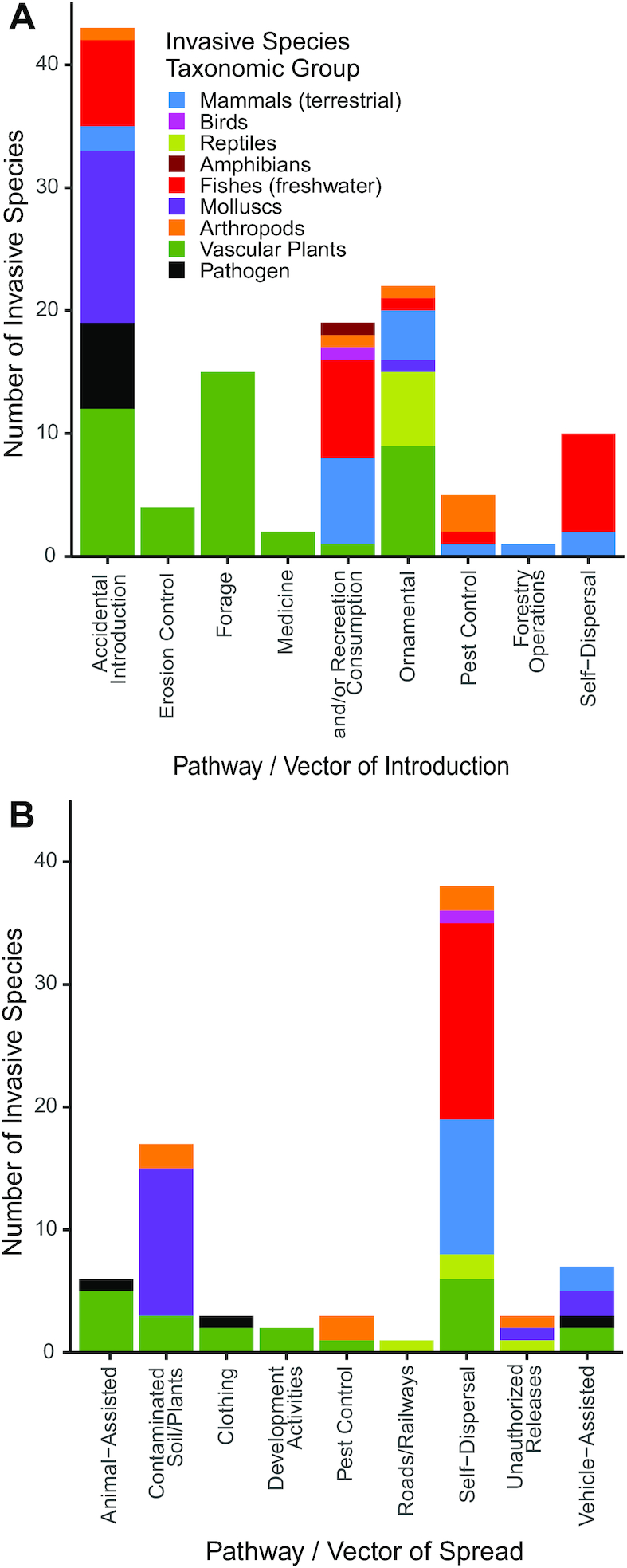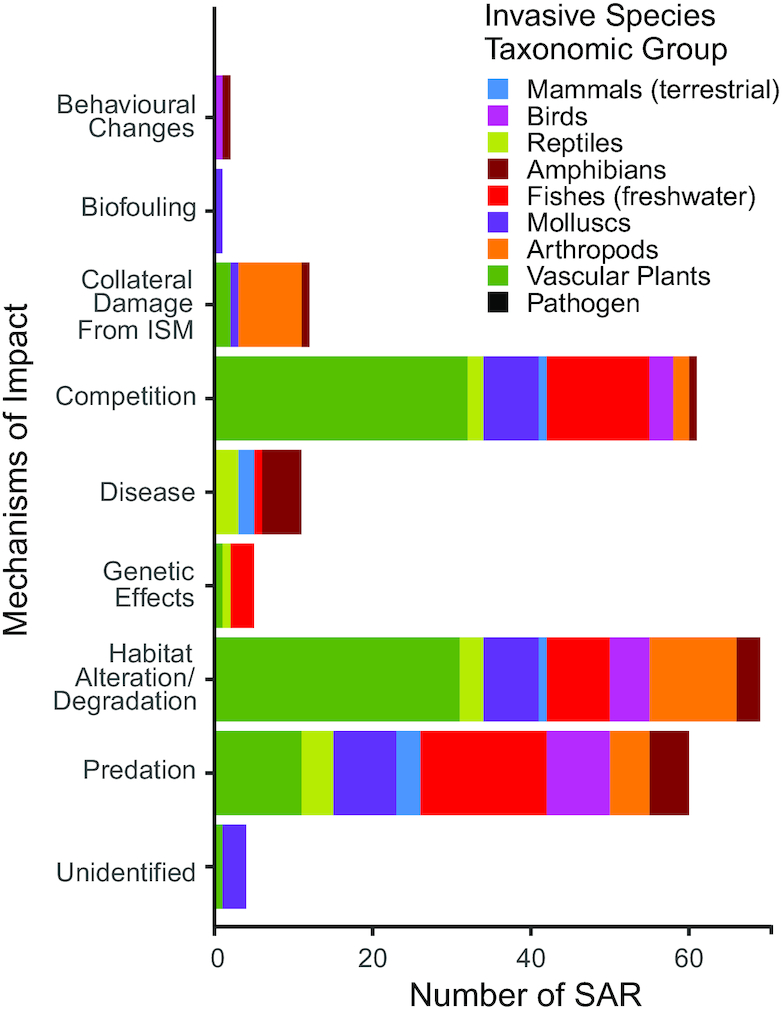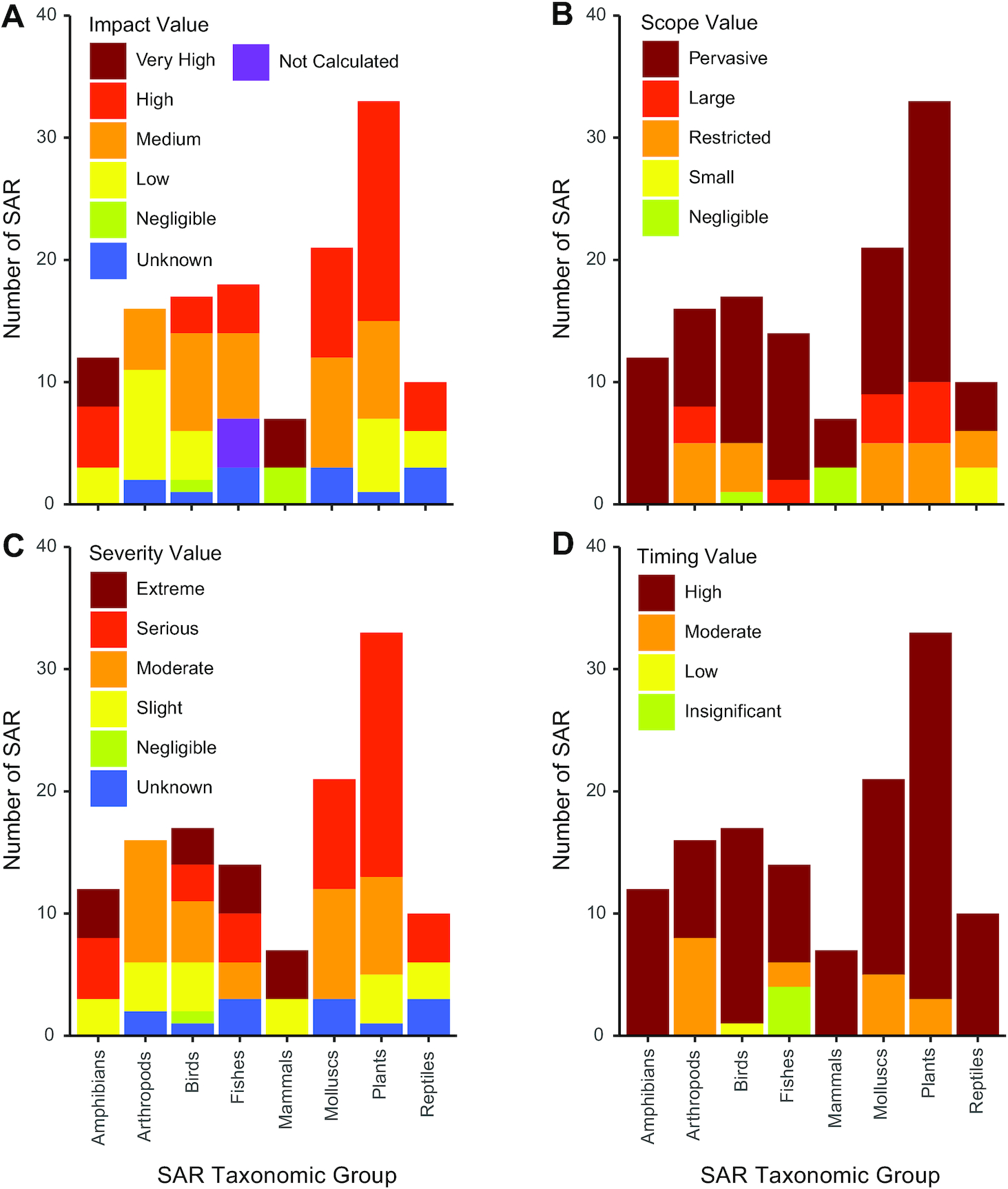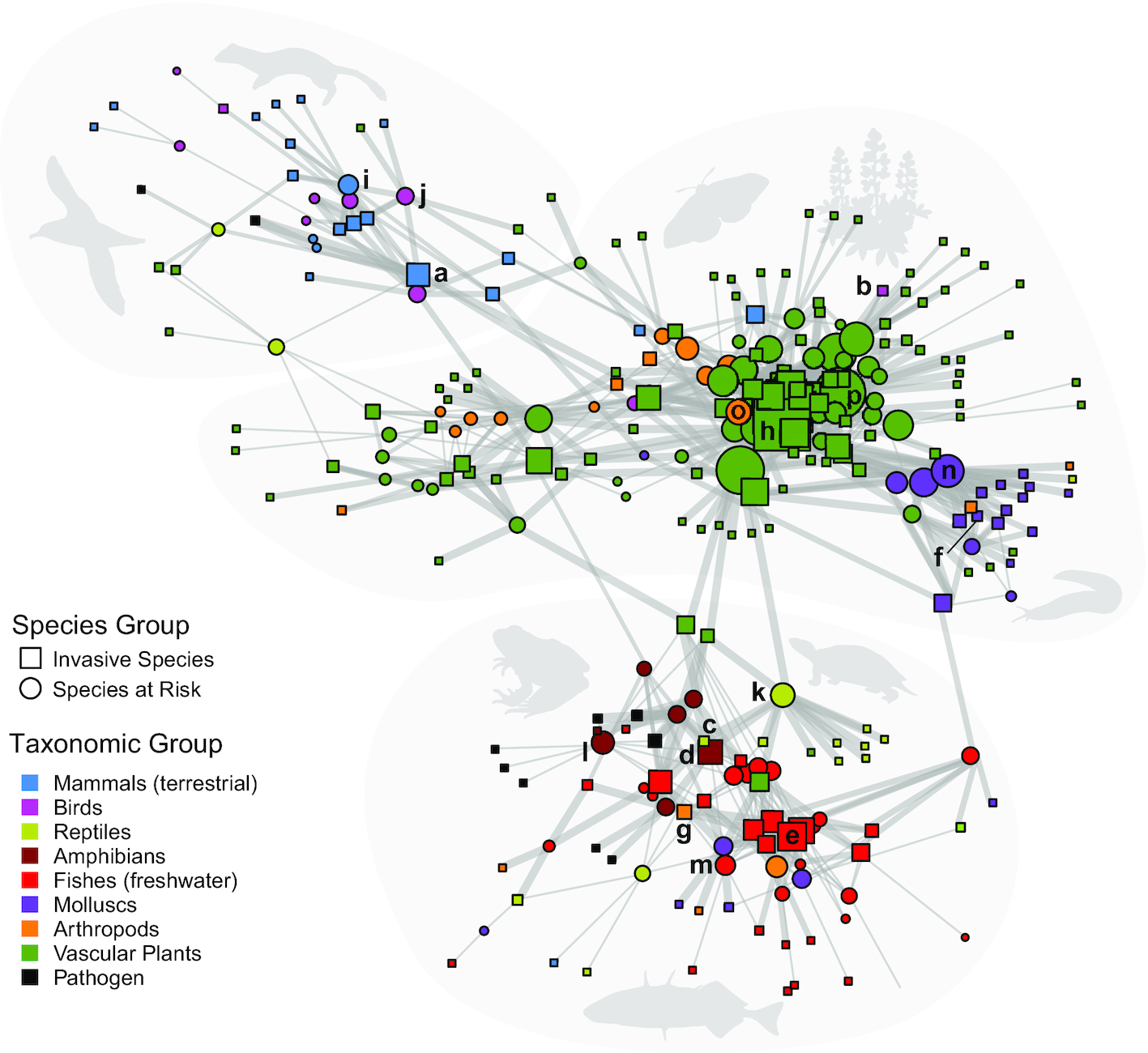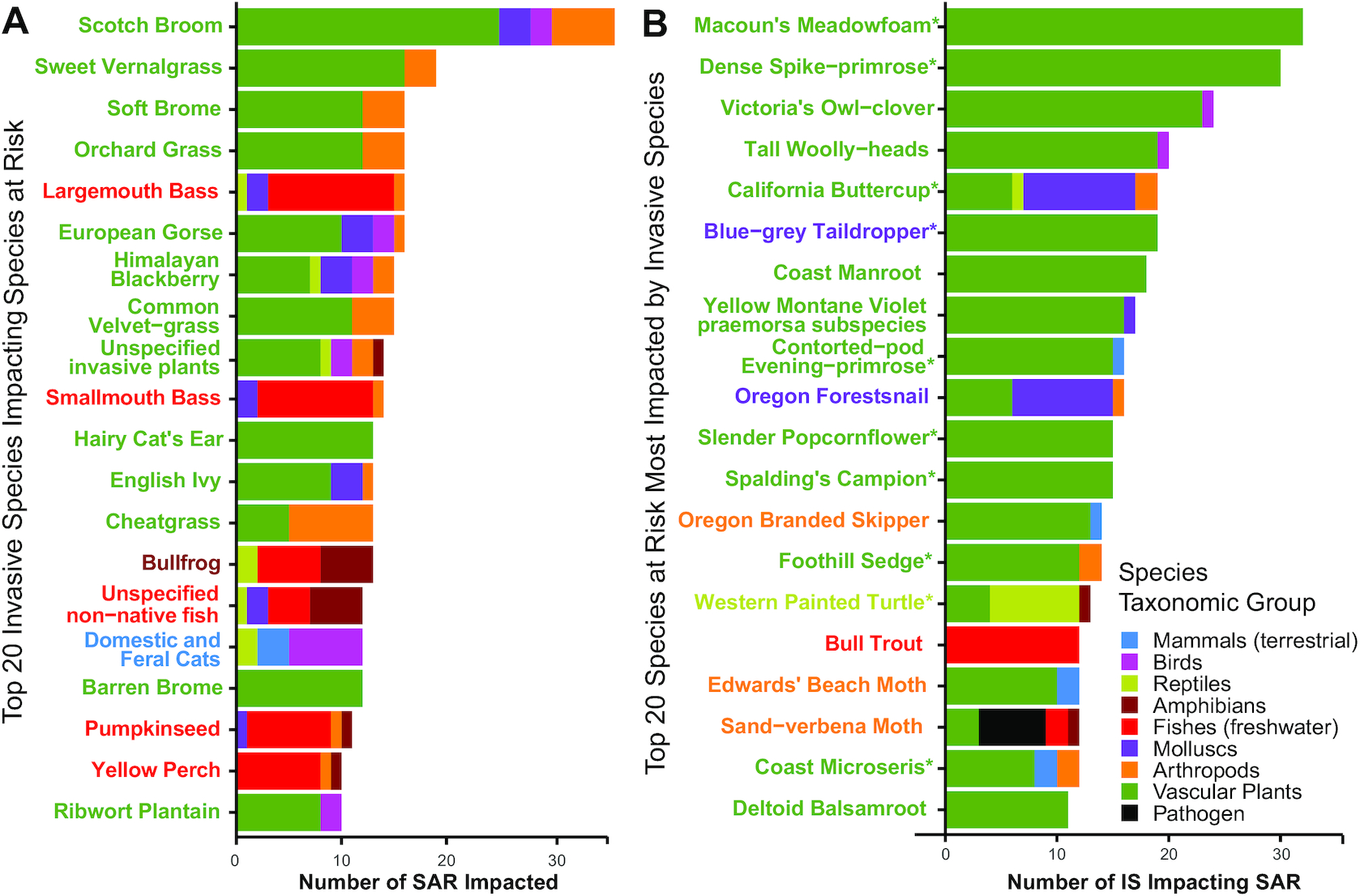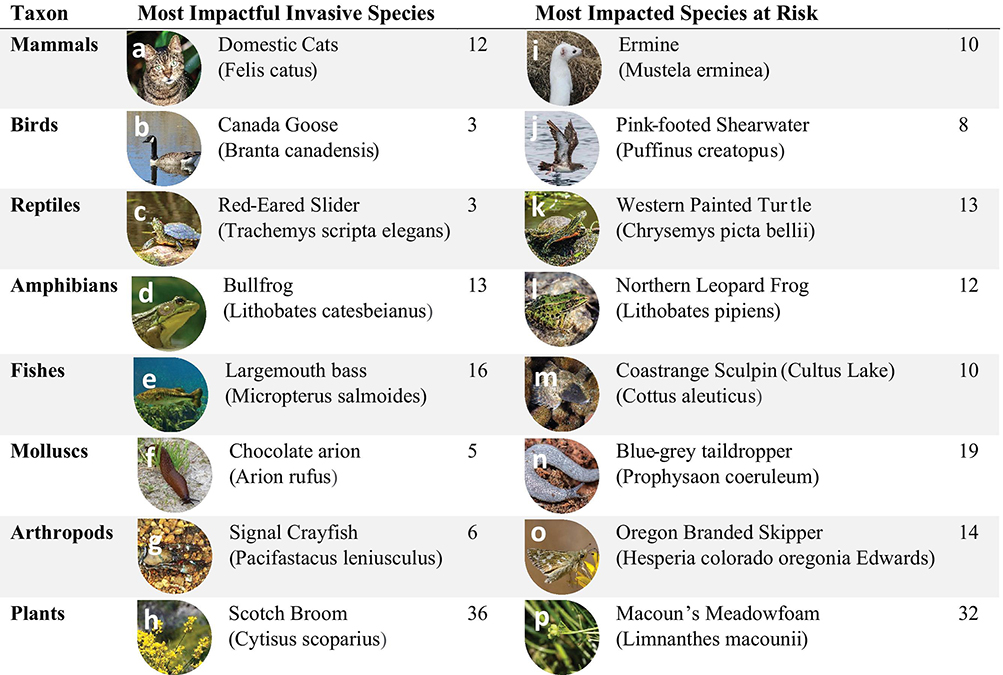Introduction
Given their major role in extinction and biodiversity loss, management of invasive species is a top priority for global conservation efforts (
Dueñas et al. 2021). However, the historical and ongoing focus on single-species management of both invasive species and species at risk contributes to inefficiencies in management strategies that present obstacles to achieving desired management outcomes (
Burgar et al. 2019), particularly in ecosystems experiencing the cumulative impacts of multiple species invasions (
Montgomery et al. 2012). A more holistic approach that consolidates existing knowledge to map pathways and impacts among co-occurring invasive species and species at risk in a geographic area of interest provides a more appropriate entry point for prioritizing management actions within an ecosystem-based management framework and is better suited to meeting multiple conservation objectives (
Poos et al. 2008;
Kumschick et al. 2012;
McGeoch et al. 2016).
British Columbia (BC), Canada, is an example of a region in which conservation and management efforts could benefit from a detailed understanding of interactions between invasive species and species at risk. BC is Canada's most biologically diverse province (
Cannings et al. 2005) and is facing a biodiversity crisis, with over 200 native species formally listed under Canada's national
Species at Risk Act,
2002 (SARA) (
Government of Canada 2020), 100 additional species assessed as being at risk by the federal Committee on the Status of Endangered Wildlife in Canada (COSEWIC) but not yet formally listed under SARA, and hundreds more identified as being at risk at a provincial scale (
Government of British Columbia 2020). Invasive species are frequently and increasingly identified as one of the most critical threats to Canadian species at risk (
Venter et al. 2006;
McCune et al. 2013;
Woo-Durand et al. 2020), with recent research suggesting they pose a threat to at least half of all federally listed species at risk in BC (
McCune et al. 2013;
Woo-Durand et al. 2020). Although prior work has documented some of these broader ecological (e.g.,
Rankin 2004;
Gayton 2007;
Voller and McNay 2007) and economic (e.g.,
Frid et al. 2009;
Robinson et al. 2013) impacts in BC, many knowledge gaps remain regarding the nature, extent, and severity of these impacts across the province. Jurisdictional fragmentation of responsibilities for the management of both species at risk and invasive species in the province further complicates the potential for integrated management of these related conservation issues. At the provincial level in BC, there is no stand-alone legislation for species at risk, which instead receive piecemeal protection under various statutes (e.g.,
The Wildlife Act,
The Forest and Range Practices Act,
The Oil and Gas Activities Act, and
The Private Managed Forest Land Act) and are managed by either Provincial or Federal agencies depending on jurisdiction according to the Canada-BC Agreement on Species at Risk of 2005. Similarly, invasive species are addressed through diverse statutes (e.g.,
Weed Control Act,
Fisheries Act, and
Wildlife Act) and managed through the BC Inter-Ministry Invasive Species Working Group, which identifies high-risk priority invasive species for management but has not explicitly considered interactions with species at risk while doing so (
Rankin et al. 2004;
IMISWG 2014,
2020).
We present a case study of the collective impacts of invasive species on species at risk based on a review of their recovery plans, with the objectives of identifying emerging patterns and trends across species and taxa that help shed light on the cumulative impacts of invasions on conservation efforts and demonstrating how this information can support the development of more holistic invasive species management strategies.
Materials and methods
The selection of species at risk for assessment was carried out through a series of screening steps. Selection began by first reviewing raw data from two previous studies of threats to Canadian species at risk (
McCune et al. 2013;
Woo-Durand et al. 2020), which had already identified species at risk for whom invasive or other problematic species were noted in COSEWIC status assessments and/or SARA recovery plans as an important contributor to threat status. Based on these studies, a species list was developed including all species at risk for which invasive species had been identified as a key threat, and this initial list was further filtered to only include species at risk with a range that includes BC and/or the Pacific Ocean. All pertinent documentation released after the publication of these previous studies and available on Canada's Species at Risk Public Registry was also reviewed to capture more recent changes and add any recently listed species (in BC and/or Pacific Ocean) to the species list.
The list of species at risk for assessment underwent a second-pass screening to confirm documented threats by invasive species within BC for documentation developed at a national scale. In this second-pass screening, available COSEWIC assessments and status reports, recovery strategies, and management plans for each species at risk were searched for the terms “invasive”, “non-native”, “alien”, “exotic”, and “introduced”, and any threats that are potentially relevant in the BC context were noted, including threats from invasive species not currently in BC but which are expected to expand into BC in the future.
Finally, to maximize the relevance of our assessment for applied management planning, a third-pass screening was applied to focus on the subset of species at risk flagged as being impacted by at least one invasive species that is also included on BC's Provincial Priority Invasive Species List (
IMISWG 2020), which identifies invasive species within the province that are considered management priorities due to their impacts and/or management potential. The species remaining after this third-pass screening are the focal species at risk for the remainder of this study.
However, impacts of invasive species not on the Priority List were still documented for the focal species at risk where these were mentioned. Moreover, our review applies a definition of invasive species that includes any non-native species that may be impacting species at risk, including species that are only regionally non-native and may be considered native elsewhere in BC.
A literature review of SARA documentation (i.e., COSEWIC assessment and status reports, recovery strategies, and action plans) was carried out for the focal species at risk and supplemented as needed with additional literature searches to fill knowledge gaps. Additional literature searches were conducted on Google Scholar using search term strings such as “species name” AND “invasive”, and in some cases additional search terms such as “introduced”, “spread”, “pathway”, or “vector”, both with and without the additional term “British Columbia” in an effort to identify regionally-specific studies. All of this literature is documented within the database compiled for analysis, which is available through the data repository Figshare (Data:
https://doi.org/10.6084/m9.figshare.21508062). For each species at risk, we documented data (where available) on variables including common and scientific name, taxon, population name (if applicable), COSEWIC conservation status, most recent COSEWIC assessment date, SARA Schedule 1 status, date listed under SARA, all invasive species noted as posing a threat to the species at risk, broad geographic areas of greatest impact, mechanisms of impact of invasive species on the species at risk, and pathways (i.e., route of invasion) and vectors (i.e., means of travel within a pathway) of introduction and/or spread of the invasive species.
Where available, assessments of the magnitude of the threat (broken out into scope, timing, severity, and impact associated with the threat) posed by the invasive and other problematic species were based on standardized national threat calculators for species at risk. As more than one threat calculator was used to assign levels of threat across the documents examined, we developed a rubric for translating scores from the less commonly used calculator to the more commonly used calculator to facilitate cross-species comparisons (see Supplementary Material for details). We also merged our data with data from previous studies on other types of threats known to be affecting species at risk (
McCune et al. 2013;
Woo-Durand et al. 2020) to investigate whether species at risk impacted by invasive species are also more likely to be impacted by other threat categories.
The data emerging from our literature review were summarized and plotted using RStudio version 1.3.1073 (
R Studio Team 2020) running R statistical software (
R Core Team 2020). This included the use of the igraph package (v.1.3.1;
Csardi and Nepusz 2006) to map the network of interactions between invasive species and species at risk across our dataset. For each node (i.e., invasive species or species at risk) in the network, we calculated degree centrality, which is the number of edges (i.e., connections) each node has; in other words, we counted the number of invasive species impacting each species at risk and the number of species at risk impacted by each invasive species.
Results
Our initial review identified 169 species at risk in BC, of which invasive species were identified as a threat. Of these, only a subset was impacted by at least one Provincial Priority Invasive Species, leaving 92 species at risk for additional assessment. When accounting for multiple invasive species impacting many of these species at risk, a detailed assessment captured information on 782 unique pairs of species at risk and invasive species. Data generated and analyzed during this study, along with the code used for analysis, are available through the data repository Figshare (data:
https://doi.org/10.6084/m9.figshare.21508062; code:
https://doi.org/10.6084/m9.figshare.21508059).
What are the pathways or vectors of introduction and spread for invasive species impacting species at risk?
Presumed or confirmed pathways or vectors of introduction to Canada were identified for 111 invasive species impacting the subset of species at risk considered in this study (
Fig. 1—panel A). Slightly over half of these were presumed or known to be introduced accidentally (
n = 48) or through self-dispersal (i.e., independent movement of the organism;
n = 15). The rest were intentionally introduced for erosion control, as forage for livestock, for medicinal purposes, for consumption and/or recreation, as ornamental plants or pets, for pest control, or for forestry operations.
Presumed or known pathways or vectors of spread were identified for 65 invasive species (
Fig. 1—panel B). The majority spread by self-dispersal (
n = 39). Other key vectors of spread include contaminated soil or plants (
n = 17), vehicles (
n = 7), and animals (
n = 7).
Through what ecological mechanisms do invasive species impact species at risk?
Eight mechanisms through which invasive species impact focal species at risk were identified in SARA documentation (
Fig. 2): (1) behavioural changes (changes to regular habits or responses); (2) biofouling (accumulation of invasive species on species at risk); (3) collateral damage from invasive species management (ISM) (to non-target species); (4) competition (interaction for the same resources); (5) disease (negative effects from fungi, parasites, viruses, etc.); (6) genetic effects (hybridization, gamete wastage, etc.); (7) habitat alteration or degradation (changes to the environment); and (8) predation (invasive species consuming animal or plant species at risk).
Habitat alteration or degradation, competition, and predation are the primary mechanisms through which invasive species impact the focal species at risk and affect species at risk across all taxonomic groups. The effects of other mechanisms were more constrained to specific taxa, with notable examples including genetic effects primarily impacting fishes, reptiles, and vascular plants; disease primarily affecting amphibians, reptiles, and mammals, and collateral damage from ISM primarily affecting arthropods. Over a third of all species at risk (n = 60) were affected by invasive species through more than one mechanism of action (range = 1–5 mechanisms).
To what degree are invasive species impacting species at risk?
Values (i.e., ratings) of the scope, severity, and timing of the threat from invasive and problematic species were available for 67 of the focal species at risk, and impact values were available for 69 species (
Fig. 3). The scope of the threat from invasive and problematic species, which refers to the proportion of the species that is expected to be impacted by a threat within 10 years, is
pervasive for most species at risk within most taxonomic groups. Similarly, the timing of the threat is
high for the majority of species at risk within each taxonomic group, meaning that the threat is continuing, as opposed to having taken place in the past (insignificant) or possibly occurring in the future (low–moderate). The severity of the threat refers to the level of damage to be expected from the threat within 10 years or three generations, and this varies in and across taxonomic groups. Some species at risk in the taxonomic groups of amphibians, birds, fishes, and mammals have
extreme severity values, indicating a level of damage that ranges from 71%–100%.
Impact is the degree to which the species is known or suspected of being threatened and is based on scope and severity values for present and future threats only. There are a wide range of calculated impacts in and across taxonomic groups, but many taxa are found to have a high proportion of species at risk with high or very high overall impact values.
Are some invasive species responsible for impacts on a disproportionate number of species at risk?
The network diagram revealed three broad clusters aligning with ecological communities: (1) terrestrial plants and invertebrates (vascular plants, arthropods, and mollusks), (2) terrestrial vertebrates (mammals and birds), and (3) aquatic species (fishes, reptiles, amphibians, and mollusks) (
Fig. 4). Here, the nodes represent species, and the lines represent the impact of the invasive species on the species at risk within each pair, where thicker lines represent higher impact values for that interaction. Invasive species tend to impact more species at risk within their own cluster than those in other clusters, but these clusters are not entirely discrete—a subset of linkages span clusters and taxonomic groups. For example, the Western painted turtle (
Chrysemys picta bellii) is impacted by invasive species in both the aquatic and terrestrial plant and invertebrate species clusters, while the domestic cat (
Felis catus) is an invasive species impacting species at risk in both the terrestrial vertebrates cluster and the terrestrial plant and invertebrate cluster.
The mean number of species at risk impacted by a given invasive species was four. However, calculations of degree centrality reveal that some invasive species are impacting a disproportionately larger number of species at risk, and similarly, some species at risk are impacted by a disproportionately high number of invasive species (
Table 1). Some invasive species impacted a disproportionately high number of species at risk (i.e., more than three standard deviations beyond the mean number of species at risk impacted), the most impactful species being Scotch broom (
Cytisus scoparius), which is a vascular plant listed as a threat for 36 species at risk. Many of the other invasive species that are most impacting species at risk are also plants (
Fig. 5—panel A). Other disproportionately impactful invasive species taxonomic groups include fishes, one amphibian (American Bullfrog,
Lithobates catesbeianus), and one mammal (Domestic Cat
, F. catus).
The majority of the top 20 species at risk impacted by the most invasive species are also plants (
Fig. 5—panel B), but this group also includes arthropods, a reptile, and a fish. Half of the most impacted species at risk have impact values of
very high or
high, and are also associated with
extreme or
serious severity values. Species at risk tend to be impacted by invasive species in the same taxonomic group.
What other threats are associated with species at risk already under threat by invasive species?
Many of the factors contributing to the acceleration of species invasions, including expanding global trade networks, continuing habitat degradation, and accelerating climate change, also pose direct threats to species at risk (
McCune et al. 2013;
Early et al. 2016;
Currie and Marconi 2020;
Woo-Durand et al. 2020). On average, species at risk examined in this study were impacted by three other threat categories in addition to invasive and problematic species (see Supplementary Material).
Discussion
Many jurisdictions are moving towards more holistic approaches to conservation to improve management outcomes (e.g.,
Downey et al. 2005;
Olsson et al. 2008;
Bunsha 2012;
ECCC 2023;
Camaclang et al. 2021;
Harvey et al. 2021). However, systematic approaches to invasive species management planning and prioritization are often hindered by a lack of information arising from both true data gaps and the fragmentation of existing data (
Courtois et al. 2018;
Wallace et al. 2020). This study serves as an example of the opportunity to help fill these gaps through the consolidation of information fragmented across hundreds of individual species at risk assessments and recovery plans to reveal emerging patterns. In doing so, this study contributes to a more holistic understanding of the effects invasive species are having on species at risk in an ecological community context and strengthens the evidence base available for informed collaborative management planning and decision-making.
Characterizing invasive species impacts across species at risk reveals emerging patterns and priorities
Invasive species impacts on species at risk manifest through diverse ecological mechanisms and pose significant and ongoing threats to species at risk in BC. Most invasive species with identified pathways or vectors of introduction are the result of accidental introductions or self-dispersal, with some notable exceptions—for example, nearly all freshwater fishes included in our study were intentional introductions to support recreational fisheries. Despite the drastic increases in invasive species introductions over the past century, and especially in the past 50 years (
Seebens et al. 2017;
IPBES 2019), many of the top invasive species found to be impacting focal species at risk (e.g., Scotch broom (
C. scoparius), sweet vernal grass (
Anthoxanthum odoratum), and largemouth bass (
Micropterus salmoides)) were introduced over 100 years ago. However, these invasive species included some recent introductions, such as snapping turtle (
Chelydra serpentina), which is native to eastern North America but was observed on Vancouver Island in 2012. It is possible that more recent invaders have not yet manifested their full impact on species at risk, due to a lag phenomenon known as “invasion debt” (
Dueñas et al. 2018) and, that once more fully established, these species may figure more prominently among those invasive species impacting the most species at risk.
When established in a region where species at risk are present, invasive species impact the populations of species at risk through diverse, and often multiple, mechanisms. Habitat degradation and alteration, predation, and competition are the primary mechanisms of impact, corroborating the outcomes of a similar exercise carried out for species at risk listed under the US Endangered Species Act (
Dueñas et al. 2018). This study found that while impacts from habitat degradation and alteration as well as predation were roughly evenly distributed across the taxa examined, competition was much more common among molluscs, freshwater fishes, and plants, all species with limited or no dispersal abilities. This outcome was most prominent among plants, which were dominated by plant-to-plant interactions and where competition is likely exacerbated by a tendency for invasive and threatened plants to occupy the same functional and adaptive niche in invaded habitats (
Dalle Fratte et al. 2019). The coexistence of invasive and at-risk species within the same community increases the risk of collateral damage from broad-acting management measures such as mowing or the application of herbicides and often requires the use of more targeted but labour-intensive methods such as manual removal to mitigate the risks of non-target effects (
Wade and Grant 2022). In contrast, the smaller subset of invasive species impacting different taxonomic groups than their own may act as mediators for impacts spanning multiple habitats and ecosystems, potentially raising the risks of more widespread ecological disruption requiring more systemic management strategies. In this study, other mechanisms of impact were less common and often localized to a subset of taxa; however, many of these rarer mechanisms of impact are known to have disproportionate effects. For example, the introduced fungal pathogen causing chytridiomycosis in amphibians has spread rapidly across BC (
Govindarajulu et al. 2010,
2017;
Brunet et al. 2020) and globally (
Fisher and Garner 2020), with devastating effects on host populations that have in some cases led to extirpations.
For a majority of focal species at risk across taxonomic groups, the scope of threats from invasive species and other problematic species is pervasive and the timing is high (i.e., current and continuing). Although more variable, the severity and impact values of the threat from invasive species also tend to be toward the upper ends of their respective spectrums within most taxonomic groups, underscoring the urgent need to address invasive species threats for these species.
Leveraging multispecies approaches for invasive species management and species recovery planning
The information generated from multispecies synthesis such as ours provides an important source of both quantitative data to inform the prioritization of interventions as well as qualitative information to support the development of targeted implementation plans for these interventions.
The simplest approaches may seek to prioritize management interventions according to those species at risk that are most impacted or the invasive species responsible for the greatest impacts (e.g., Kumschick et al. 2018). For example, Macoun's meadowfoam (Limnanthes macounii) is the species at risk impacted by the greatest number of invasive species (n = 32) and is also associated with a high impact value and serious severity value, suggesting significant benefits of broad invasive species management efforts in areas of critical habitat for this species. Conversely, Scotch broom (C. scoparius) impacts the most focal species at risk (n = 36), and so management efforts targeting this invader could have broad conservation benefits for many species at risk as well as additional benefits for other native species. While this species is already represented on BC's Priority List of Invasive Species, it is notable that sweet vernal grass (A. odoratum), the second-most impactful invasive species identified in this study, is not, demonstrating how these types of synthetic analyses can inform further refinement of management priorities.
Information about pathways and vectors of introduction and spread that transmit the greatest number of invasive species, or the most impactful invasive species, can support the development of management interventions targeting pathways of invasion (
McGeoch et al. 2016;
Marsh et al. 2021). For example, our study found that invasive species are frequently introduced as ornamental plants or in the soil of non-native plants, which could be addressed through programs like PlantWise, which focuses on transitioning the horticultural industry away from sales of the more impactful invasive plant species (
ISCBC 2023), or operational guidelines for industry, which focus on providing information on invasive species most likely to be introduced or spread via relevant industry pathways (e.g., roads and railroads) or vectors (e.g., vehicles and forestry equipment) (
ISCBC 2019a). Where voluntary measures are ineffective, mandated biosecurity protocols targeted at the most important vectors of spread (e.g., decontamination of footwear and vehicles or restricting entry points and traffic into sensitive areas) can help make the best use of limited resources (
Brancatelli and Zalba 2018;
Coughlan et al. 2020).
The synthesis of information on invasive species interactions and impacts is also critical for supporting more complex prioritization schemes considering costs and benefits across multiple species, stakeholder groups, and broader conservation objectives. For example, this type of information would represent a valuable input to priority threat management or other structured decision-making approaches to conservation decision-making, where the objective is to compare the cost-effectiveness of alternative strategies to recover as many species as possible per dollar invested to make the best use of limited management budgets (
Januchowski-Hartley et al. 2011;
Courtois et al. 2018;
Martin et al. 2018,
Camaclang et al. 2021;
Gregory and Beck 2021). In such a process, an invasive species control option initially considered cost prohibitive may be rated differently once considering trade-offs given the cumulative number and threat status of species at risk potentially benefiting.
As the conservation community is increasingly called to move beyond single-species recovery plans (
Westwood et al. 2019), information on the identity, mechanisms, and magnitude of species interactions also provide critical inputs for more ambitious community- or ecosystem-based recovery plans that may be informed by multispecies population models (
Poos et al. 2008;
Lester et al. 2010;
Burgar et al. 2019). Such approaches can help better evaluate management trade-offs in light of the potentially complex interactions between multispecies assemblages of invasive species and species at risk, such as in the case of threatened plains bison (
Bison bison bison) that facilitate the dispersal of invasive plants posing a threat to the native rough fescue (
Festuca hallii) grasslands over which they roam (
Sigaud et al. 2020).
The consolidated dataset linking multiple invasive species and species at risk produced by this study can help to provide a bridge between existing species at risk and invasive species management strategies in the province of BC to support coordinated planning, prioritization, and cost-sharing of management activities better able to account for the potential trade-offs and unintended consequences of management actions (e.g.,
Rankin et al. 2004;
IMISWG 2014,
2020) and can also inform future research and management priorities (e.g.,
ISCBC 2020).
Toward spatially explicit approaches to inclusive and adaptive multispecies management
When coupled with additional spatial information, information on multispecies interactions can provide a powerful tool for further spatial prioritization, supporting targeted implementation of the most promising interventions identified through management planning.
A logical next step to the information synthesis carried out here would be to compile spatial data enabling an analysis of overlaps in either species observations or modelled habitat suitability between priority invasive species and/or species at risk, where such information is available (e.g.,
Allen et al. 2006,
2015;
Coristine et al. 2018;
Anas and Mandrak 2021). Such spatially explicit analyses would help to identify and triage areas of greatest potential impacts on species at risk to efficiently allocate limited management resources and tailor management interventions to regionally specific mechanisms of dispersal and local management contexts.
Such analyses could also help to incorporate community objectives for conservation, for example, by identifying areas where interactions between invasive species and species at risk intersect with public lands, private lands, or areas of significance to Indigenous peoples to inform targeted community-based management efforts of the kind already being implemented in some parts of the province (
ISCBC 2019b). This approach would help to support the growing movement for greater representation of Indigenous voices in deliberations regarding the management of both invasive species and species at risk, given that they are critical partners in on-the-ground species control and conservation efforts across their ancestral lands and beyond (
Bhattacharyya and Larson 2014;
Reo et al. 2017;
Hill et al. 2019;
Turcotte et al. 2021).
Another rapidly emerging research focus is understanding the management implications of evolving interactions between invasive species and global climate change as regionally downscaled climate projections become available for climate-informed, spatially explicit species distribution and population models. Climate change is already driving range shifts of both native and non-native species and accelerating the introduction and spread of invasive species (
Hellman et al. 2008;
Walther 2011;
IUCN 2021) and it is also likely to alter the impact of existing invasive species and the effectiveness of current control strategies (
Hellman et al. 2008;
Mainka and Howard 2010). In some cases, invasive species may also exacerbate climate-change impacts on native species by reducing the climate resilience of natural habitats (e.g., by providing less shade than native species or contributing to more severe fire events) (
Balch et al. 2012;
IUCN 2021).
There is an urgent need for targeted research to understand current and future spatial overlaps between interactive invasive species and species at risk and explicitly incorporate them into management strategies for both (
Mainka and Howard 2010;
Beaury et al. 2020). For example, the use of assisted colonization may help species at risk to keep pace with the more rapid climate-induced range shifts of invasive species or to relocate these species to climate refugia where they will be more resilient to the effects of invasions (
Gallagher et al. 2015).
The unincluded, understudied, and unappreciated: caveats and other considerations
In considering future research and management approaches based on the findings of this type of synthesis, some caveats and considerations must be noted. First, this review is biased toward terrestrial and freshwater interactions between invasive species and species at risk. This is in part because the Provincial Invasive Species Priority List does not include any marine species, but also because interactions between marine invasive species and species at risk are more difficult to study and their interactions are not yet well understood (
Clarke Murray et al. 2011;
Howard et al. 2018). Similarly, this study does not consider taxonomic groups of species at risk that are not assessed by COSEWIC (e.g., fungi).
It should also be noted that the simple pairwise interactions we examined in this study did not capture important contextual information on potential additive, synergistic, or agonistic relations that have potential implications for the effects of community context on the outcomes of management interventions. For example, multiple invasive species occurring in the same ecosystem may have only a weak influence on one another but a strong, additive, or synergistic influence on native species (
Johnson et al. 2009;
Preston et al. 2012), and targeted removal of one invasive species among many may have unintended negative consequences on native species due to competitive release or other cascading mechanisms (
Ballari et al. 2016). There are also some counterexamples where invasive species were found to benefit species at risk or local communities—in Oregon, Taylor's checkerspot butterfly (
Euphydryas elitha taylori) is listed as endangered and has become dependent on the exotic larval host plant English plantain (
Plantago lanceolata) for its survival (
Severns and Warren 2008). Beneficial interactions like this may become more common in the future because invasive species may be more likely than native species to persist and provide substitute ecosystem services in areas where land use and climate are rapidly changing (
Schlaepfer et al. 2011). For such species, trade-offs between potential impacts and benefits of interventions must be carefully considered in management planning. For example, the level of impact in future iterations of the network diagram might be modified if dependencies or synergistic relationships are identified for any invasive species—species at risk pairs. This could help tailor management planning for species that typically co-occur, such as threatened bear's-foot sanicle (
Sanicula arctopoides), endangered coastal scouler's catchfly (
Silene scouleri ssp.
grandis), endangered prairie lupine (
Lupinus lepidus), endangered seaside birds-foot lotus (
Lotus formosissimus), and endangered Taylor's checkerspot butterfly (
E. elitha taylori), which are often found together within maritime meadows associated with at-risk Garry Oak ecosystems.
Although this study focused on a regional application, this approach is easily adaptable to a national scale, drawing on the newly established CAN-SAR database of Canadian Species at Risk Information (
Naujokaitis-Lewis et al. 2022) as a starting point of information for impacts from invasive species to a broader set of species at risk. Establishing a national baseline characterizing the impacts of invasive species on species at risk would support a balanced approach to species recovery by helping to identify knowledge gaps that could be filled through research and monitoring initiatives, contributing to more effective regional management planning, serving to inform national recovery planning for species at risk, and supporting a more comprehensive national response strategy for invasive species (
Buxton et al. 2022). In these and other ways, drawing out the emergent properties of existing but disparate data through synthesis presents an important but often overlooked approach to more informed decision-making that can assist conservation practitioners in crafting coordinated and complementary management strategies for invasive species and the species at risk with which they interact to yield more efficient use of resources and more effective conservation outcomes.
